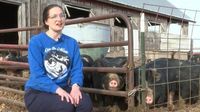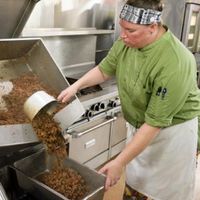Central City, Iowa — Iowa’s small farms, once counting on a renewed federal program to keep their harvests flowing into schools and food banks, have been left scrambling after the U.S. Department of Agriculture abruptly canceled more than $11 million in promised funding. The move comes just months after the initiative was extended through 2028, dealing a sudden blow to farmers who say they had begun planting more crops, hiring staff, and forging new supply-chain partnerships.
The cuts eliminate the Local Food Purchasing Assistance (LFPA) and Local Food for Schools (LFS) programs, which provided $7.8 million in local food purchases in Iowa during the past three years. Both programs were renewed in October 2024 for an additional three years, extending into 2028. But in January, the Trump administration opted to pull the $11.3 million in renewed funding.
In Central City, Buffalo Ridge Orchard co-owner Emma Johnson said the canceled funds had been a cornerstone of her expansion strategy. “When this program came through, it enabled us to expand our business, plant more trees, and know that there was a secure outlet to send our products,” she said. Last year alone, Johnson sold close to $100,000 worth of apples and produce through the program.
As for Anna Pesek, co-owner of Over the Moon Farm in Delaware County, around 10 to 20 percent of her revenue derived from the two programs. “It’s not everything, but it is sizable,” Pesek noted. She expressed concerns about small farms often operating on razor-thin margins and unable to withstand sudden disruptions.
The USDA previously paid farmers fair prices for fruits, vegetables, dairy, and meat, with those products distributed to institutions such as schools, childcare centers, and food banks. The loss of these funding opportunities not only implicates individual farms but could disrupt the entire supply infrastructure built over recent years. “The loss is actually greater than my individual farm and what I’m losing this season,” Johnson said. “The loss is all that infrastructure that was built really quickly in 2025—just stripped away.”
Don McDowell, a spokesperson for the Iowa Department of Agriculture, expressed that this situation should not come as a surprise, considering the program was announced via executive action rather than being legislatively directed. He stated, “We will continue to pursue future opportunities to grow markets for local farmers and Iowa grown and raised foods,” referencing a newly announced $70,000 Choose Iowa Food Purchasing Pilot Program for Schools, which pales in comparison to the $11 million funding loss.
The ramifications of these cuts extend beyond Iowa. Emma Jagoz, the owner of Moon Valley Farm in Maryland, voiced grave concerns regarding her operations after being informed the USDA was canceling grants that were pivotal to her capability to serve local schools. Jagoz saw contracts for local food procurement vanish just as she was prepared to fulfill substantial orders and expressed that many children depend on these meals as their primary source of nutrition.
“What this means from a bigger picture is that people are not going to have access to as much local food, and our farmers are already going into debt,” Jagoz commented. The USDA's halting of its Local Food for Schools Cooperative Agreement Program and Local Food Purchase Assistance Cooperative Agreement Program has triggered widespread alarm among farmers and food advocates alike.
Meanwhile, reports from the Brazos Valley Food Bank in Texas highlighted how these changes could force food banks to rethink their operations entirely. “What we were able to get was the kind of food that we don’t normally get at the food bank,” said executive director Theresa Mangapora. The loss of $660 million in funding could tighten food budgets, while $420 million allocated for local purchase assistance is now out of reach, leaving many food banks grappling with increased needs without the necessary support.
In Vermont, schools that benefited from financial support to purchase food from local farms face a similar plight. Nyssa’s nutrition director, Gina Freel, called the funding vital for providing nutritious breakfast and lunch items to students. The USDA’s recent cuts of $1.2 million aimed at these programs have drawn ire from those relying on the federal assistance to ensure children receive fresh produce.
John Wahrmund, a third-generation beef farmer in Arkansas, reflected on how vital the Local Food for Schools Program had been for his sales. After investing in infrastructure to meet school food requirements, he announced, “Without this, it will literally shut me down.” The urgency of these cancellations is underscored by stakeholders across the country.
Political responses have also emerged, particularly from congressional Democrats voicing opposition to the cuts. Senator Tina Smith (D-Minnesota) emphasized the long-standing success of connecting local farmers to school systems, denouncing the recent decisions as detrimental not only to farmers but also to children’s health. Others, like Senator Deb Fischer (R-Nebraska), expressed support for fresh food availability but also crossed paths with arguments that canned food alternatives should suffice.
As food bank leaders report cancellations of orders, including 500,000 pounds of anticipated supplies bound for California’s Central Food Bank, the situation presents a palpable sense of urgency. The emergency food programs have yet to clarify plans moving forward for the canceled deliveries, prompting fears of worsening food insecurity in many communities.
Notably, the USDA’s decisions result from a broader governmental push to reduce spending and eliminate what they perceive as wasteful programs. Yet, as advocates for local food initiatives have pointed out, those cuts jeopardize the very framework supporting American agriculture and public health.
With the onset of spring and the planting season approaching, farmers are alarmed at how these discussions will impact their livelihoods. Those previously thriving on local school contracts now face daunting uncertainty. As impactful voices converge to advocate for restoration of funding, the country awaits the USDA’s next moves.
Without reinstated funding, not only the farmers will suffer but those deprived of access to consistent and nourishing food will feel the ramifications of these abrupt changes for years to come.






